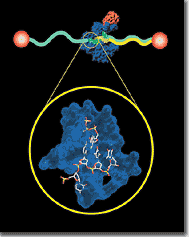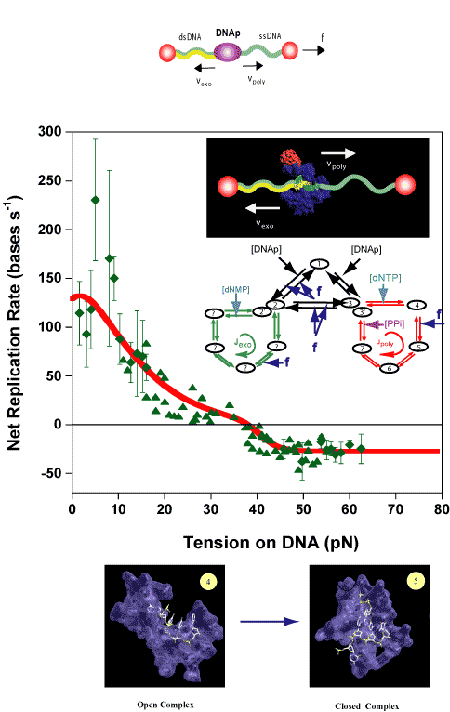Anita Goel
Anita Goel is fascinated by motors. Not the kind of motor that resides under the hood of your family car, but the molecular motors that make their way along strands of DNA, reading and replicating genetic information. They are the motors of life itself. Goel, a 29 year-old researcher in the physics department at Harvard, hopes to learn how these nanoscopic machines work. In particular, she is interested in how the environment can affect the motor's operation. “I find it intriguing,” says Goel, “that conditions within cells can affect the flow of information encoded in DNA.”

This artist's depiction of a molecular motor crawling along a DNA molecule shows the unreplicated portion of the molecule on the left (light green). The twin yellow and green replicated portion lies to the right of the molecular motor (dark blue). The beads on either end are chemically bound to the DNA molecule. Researchers can control the speed and direction of the molecular motor by grasping the beads with optical tweezers and stretching the DNA.
Hints that the environment influences these tiny machines come from the recent work of Goel and colleagues; they describe how stretching a DNA molecule can control both the speed and direction of molecular motors that replicate DNA. Researchers typically attach tiny plastic beads to the ends of a DNA strand in order to stretch it. They then grab each of the beads with optical tweezers, which consist of laser beams that can drag small objects around. The tweezers allow scientists to precisely adjust the tension on a DNA molecule. Goel points out that these relatively simple experiments lead to some interesting ideas. “For example,” she explains, “gene expression and replication may one day be artificially manipulated by controlling these motors. That may ultimately enable a new generation of therapeutic strategies.”
While visiting the Santa Fe Institute in New Mexico, Goel began thinking more deeply about theories that might adequately describe the interaction of DNA molecular motors with their environment. To Goel, the common understanding of DNA is a bit oversimplified. “We currently think of DNA as the sole source of information necessary for building a living organism. But if the environment affects the way the DNA is read and replicated, then perhaps the information embedded within the environment is also important for life. And if this proves true, it will affect our understanding of evolution, at least on the molecular level. Simply put, the environment doesn't just lead to a selection of the fittest creature's DNA. It could also change the way that cells process the information encoded in DNA.”
Goel cautions, however, “We are still far from answering such questions today. However, developing a good theoretical understanding will enable us to begin formulating the right kinds of questions and designing appropriate experiments to address them. The advent of new experimental tools certainly helps us to explore new territory.”
“Biophysics usually refers to taking techniques and tools from physics and applying them to studying problems in biology.” says Goel. “If we understand in a deeper way the design principles by which living systems work, then just maybe those same principles might give us insight into other aspects of physics?” It's a question that has inspired physicists since at least the time of the ancient Greeks. More recently Albert Einstein noted, “One can best appreciate, from a study of living things, how primitive physics still is.” Ironically, rapid advances in fundamental physics, many of which stem from Einstein's own work, have generally overshadowed perspectives of this type in the past century or so.
Through biophysics, Goel and some like-minded colleagues are just beginning to revisit such issues. While her work is founded on cutting-edge scientific developments, her outlook seems, at times, a touch philosophical, even poetic. In a paper entitled “The Physics of Life” presented at a symposium honoring John A. Wheeler, Goel (whose ethnic heritage is Indian) included a Sanskrit quote: ”The path to truth proceeds from Sruti, to Sravana, and finally to Nidyasadhana.” That is, in seeking truth we must first intuitively grasp Nature (Sruti), and then construct sound theories (Sravana). Then can we proceed to experimentation (Nidyasadhana).
For Goel, understanding molecular machines is another step on the path that leads to unveiling the physical laws that govern the universe. “There's a special kind of excitement associated with looking at life and living systems through the lens of modern physics,” says Goel.
For more information about Goel, visit her web site at Harvard.

A graph of the replication rate of a molecular motor moving along a DNA molecule shows that increasing the tension on the DNA molecule slows the replication. At about 40 pico-Newtons (.00000000004 Newtons) replication stops altogether, and at higher tension the rate turns negative as the motor changes direction and erases its previous replication work. (One Newton is approximately the force you would have to exert on a small apple to prevent it from falling due the force of Earth's gravity.)A graph of the replication rate of a molecular motor moving along a DNA molecule shows that increasing the tension on the DNA molecule slows the replication. At about 40 pico-Newtons (.00000000004 Newtons) replication stops altogether, and at higher tension the rate turns negative as the motor changes direction and erases its previous replication work. (One Newton is approximately the force you would have to exert on a small apple to prevent it from falling due the force of Earth's gravity.)











